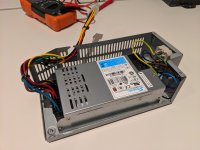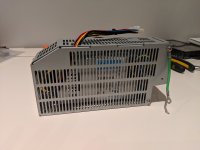I've got a Sony. I'm starting to get horizontal lines moving downward on the display. Faint, but noticeable. It didn't happen with my recapped PSU (which bit the dust for an unrelated reason a month ago). It's probably the filter caps starting to go showing the mains frequency. I'm thinking of just swapping in a new PSU rather than deal with the old and failing ones (30 year old power supplies... ). I'm kind of scared to mess with something as big as a power supply for right now. Keyboard repair I can do, maybe some minor analog board work, but PSUs are way too much to attempt.
...what would you recommend for an SE/30 with an Ethernet card that would have light use every week? New PSU or recap? My last one had a bad transistor, and I'd hate to have that happen again...
You say you have a
Sony, which implies "Sony
PSU," and then you mentioned your "
recapped PSU." So you have a PSU other than your SONY PSU that someone recapped for you? Was that an
Astec PSU? And that was the PSU you mentioned had a "
bad transistor"?
If that other failed PSU is an Astec, they do "bite the dust" and I would recommend swapping it for a Sony version. But if your failed PSU was a Sony, it may be worthwhile to replace the bad transistor, assuming you know which one it is and assuming your are absolutely sure that one transistor is the root problem.
Your light use case warrants only a recapped Sony PSU. The Sony will more than suffice. You really don't need the SEASONIC in your application. But of course, if you had a SEASONIC PSU, it would serve you well too. Which PSU requires the most work is something you must decide after watching my SEASONIC video and SONY PSU recap video. Both take time and thought. There's less soldering overall with the SEASONIC, but I would suspect most of the SONY PSU's out there merely need recaps, and it's kind of a waste to trash them, sell them for parts or merely throw them in a closet.
@JDW your YouTube video really helped me and was very entertaining. However, as a novice solderer myself, I was sweating bullets when soldering the high-voltage wiring to the PSU. When you also consider the wiring for the rocker switch, there's a lot of wires to deal with in close proximity - all enclosed in a metal box! ...[SIZE=11pt]this one is probably the most dangerous and carries a risk of electrocution. This project is not for everyone.[/SIZE]
True, but there are dangers even when working with the SEASONIC. There are dangers even opening the back case! How much of a danger depends on the person opening the back of the case and tinkering inside. No doubt there are some people who would wait until a rainy day to take their SE/30 outside, plug it in, then open the back case and start tinkering, but I suspect those types are few.

Even so, I agree that some people COULD accidentally shock themselves, especially in countries that use higher mains voltages. More likely, an inexperienced tinkerer would just end up frying a board due to an epic blunder. Goodness knows I've done that, and even recently no less! Ah... my poor 40MHz Daystar Turbo 040! :-(
You do need to discharge the CRT for safety whenever working inside the case. People who forget that are not necessarily in danger of their life because the bleeder resistor will usually drain the CRT pretty fast and those resistors aren't failing left and right either. Also, most vintage computer owners know not to touch the back of the CRT yoke (where all those scary copper wires are). So the end result is we don't hear about a lot of people getting shocked when working in these machines. I think it would be fun to poll our 68kMLA members to see if anyone has even been shocked. You need to be careful, but it's not quite as scary as some make it out to be.
I personally do
TRIPLE-CHECKS when I recap anything, and that is especially true of the PSU. You do NOT want to solder in even one cap with the polarity reversed. You most likely won't die, but the bigger the cap the bigger the explosion when the cap vents through its top. The cap itself might even fly off the PCB like a rocket -- I've seen that. For those of you who are very worried, I would recommend eye protection. Eye-glasses are OK, but I'm talking about the polycarbonate kind that you would wear when using a spinning string cutter outdoors to protect your eyes from flying debris. And I personally would not test a PSU on mains voltages that don't have a known-good breaker.
These recapping and PSU-replacement projects aren't for everyone, but it's a fact that most people are too frightened to try something new. I don't want to push a scared person too close to a cliff, but at the same time, some of us do need a little prodding to get started with something that could benefit us down the line. Yes, there are dangers, and one must be very cautious, but with care, patience, thought, a slow pace, and a detailed guide, I believe that many of our members could do these jobs if they set their mind to it. That is why I made those YouTube videos, to give people a little assistance and show them what's involved every step of the way.


